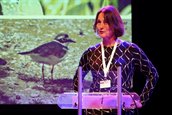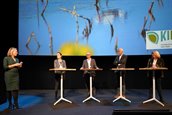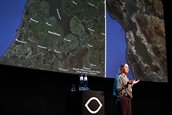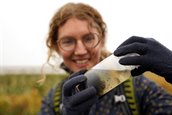'Ten years ago Marker Wadden was nothing more than a dream'
Sacha de Rijk (Deltares) explained the background of KIMA program and the importance of monitoring. She shared some main lessons learned from the different research tracks. An important finding is that a wide variety of habitats was key to the current rich high biodiversity on the islands. She praised the work of the researchers: “It was their fascination that made it possible to develop and share our knowledge today.”
“The fascination of researchers made it possible to share our knowledge”
“During the coming days we share the knowledge from five years of research and we place it in the wider context of ecosystem restoration”, said host Desiree Hoving in her opening word. Sacha de Rijk (Deltares) explained the background of KIMA program and the importance of monitoring. She shared the main lessons learned from the different research tracks. An important finding is that a wide variety of habitats was key to the current rich high biodiversity on the islands. She praised the work of the researchers: “It was their fascination that made it possible to develop and share our knowledge today.”
[Text continues below picture]

“Ten years ago Marker Wadden was nothing more than a dream, now it is a reality. Thousands of birds come to feed and rest and islands six and seven are being built”, said Roel Posthoorn (Natuurmonumenten) in his talk about lessons he learned.
“Ten years ago Marker Wadden was nothing more than a dream”
Posthoorn is seen by many as the creator of Marken Wadden. To him, Marker Wadden is the result of a unique collaboration. “I believe the energy of all of us together was key. I want to thank all the partners that joined us on this adventure.”
Dutch experiment
On the second conference day, Mark Harbers, Minister of Infrastructure and Water Management, underlined the importance of KIMA and innovative solutions, especially in light of climate change. “There is international interest in building with fine sediment as sand is becoming a scarce resource. The lessons learned at KIMA will help in concrete ways. I’m proud that we can share the knowledge of this unique Dutch experiment.”

Both days featured expert panels where participants discussed the main results and important enablers of the Building with Nature approach. Collaboration between stakeholders was seen as the most important enabler by the audience. “It’s important to keep an open mind and to learn by doing things”, said Geert de Snoo from the Netherlands Institute of Ecology (NIOO). “Have trust in each other and have trust in nature.”
“Research is the backbone for making the right decisions”
Three keynote speakers shared their perspectives on ecosystem restoration in lakes and coastal areas. Brenda Goeden (San Francisco Bay Conservation and Development) gave insight into several wetland restoration projects and plead to see sediment as a resource rather than waste.
[Text continues below picture]

Geoff Wilson of the Asian Development Bank explained how to finance Nature-based Solutions and how important it is to monetize co-benefits. Martin Søndergaard shared examples of lake restoration in Denmark and was impressed by how monitoring is intertwined with construction at Marker Wadden. “Research is the backbone for making the right decisions”, he said.
In-depth sessions
In the afternoon participants could follow in-depth sessions about different research tracks, such as the financing perspective or the main lessons from reusing silty sediment at Marker Wadden. The sessions during the second afternoon revolved around shallow lake restoration and how KIMA knowledge can be applied elsewhere. The sessions were hosted by the KIMA researchers from the partnering research institutes.
Excursion
On the final conference day participants went to see the Marker Wadden with their own eyes. In typical Dutch rainy weather they experienced what Katja Portegies (Rijkswaterstaat) said during the conference: “Once you visit the islands you will understand why this project is so special.”
